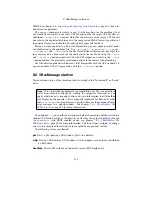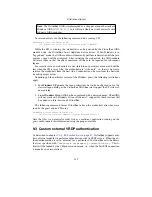
9 Advanced topics
machine called “Fedora 6” would, by default, have its settings saved in
.VirtualBox/Machines/Fedora 6/Fedora 6.xml
.
If you would like
more control over the file names used, you can create the machine using
VBoxManage createvm
with the
--settingsfile
option; see chapter
8.4
,
VBoxManage createvm
, page
107
.
The virtual machine directory will be renamed if you change the machine
name. If you do not wish this to happen, you can create the machine using
VBoxManage createvm
with the
--basefolder
option. In this case, the
folder name will never change.
•
VirtualBox keeps snapshots and saved states in another special folder for each
virtual machine. By default, this is a subfolder of the virtual machine folder
called
Snapshots
– in our example,
.VirtualBox/Machines/Fedora
6/Snapshots
.
You can change this setting for each machine using
VBoxManage
as well.
•
VDI container files are, by default, created in the
.VirtualBox/VDI
directory.
In particular, this directory is used when the “Create new virtual disk” wizard is
started to create a new VDI file. Changing this default is probably most useful
if the disk containing your home directory does not have enough room to hold
your VDI files, which can grow very large.
9.2 Automated Windows guest logons (VBoxGINA)
When Windows is running in a virtual machine, it might be desirable to perform co-
ordinated and automated logons of guest operating systems using credentials from a
master logon system. (With “credentials”, we are referring to logon information con-
sisting of user name, password and domain name, where each value might be empty.)
Since Windows NT, Windows has provided a modular system logon subsystem (“Win-
logon”) which can be customized and extended by means of so-called GINA mod-
ules (Graphical Identification and Authentication). The VirtualBox Guest Additions
for Windows come with such a GINA module and therefore allow Windows guests to
perform automated logons.
To activate the GINA module, install the Guest Additions with the command line
switch
/with_gina
.
To manually install the GINA module, extract the Guest
Additions (see chapter
4.2.4
,
Manual file extraction
, page
64
) and copy the file
VBoxGINA.dll
to the Windows
SYSTEM32
directory. Then, in the registry, create
the following key:
HKEY_LOCAL_MACHINE\SOFTWARE\Microsoft\Windows NT\CurrentVersion\
Winlogon\GinaDLL
with a value of
VBoxGINA.dll
.
128
















































